Сельскохозяйственные науки. Рубрика в журнале - Бюллетень науки и практики
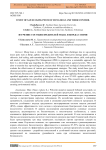
Study of sap-sucking pests of mung bean and their control
Статья научная
Mung bean, a vital legume crop, faces significant challenges due to sap-sucking insect pests such as thrips, aphids, whiteflies, and stink bugs. These pests damage plants, causing chlorosis, leaf curling, and transmitting viral diseases. These infestations reduce yield, seed quality, and market value. Integrated Pest Management (IPM) is proposed as a sustainable approach, but there is a knowledge gap regarding its effectiveness in Central Asian agroecosystems. This study aims to examine key sap-sucking pests, analyze their biological and ecological characteristics, and evaluate the effectiveness of various pest management strategies. The study tested three types of chemical pesticides against spider mites on mung bean crops at the Scientific Research Institute of Plant Genetic Resources in Tashkent region. The results showed that applying these pesticides at the specified application rates provided a biological efficacy of over 87-95% against spider mites, making them suitable for controlling spider mites on mung beans. This research aims to develop a comprehensive, sustainable pest control framework that enhances mung bean productivity while ensuring environmental safety.
Бесплатно
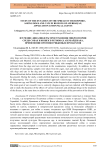
Статья научная
During 2018-2024, in the cities of Baku and Ganja, where pets are widely kept and stray dogs and cats are prevalent, as well as in the cities of Gazakh, Goygol, Goranboy, Gadabey, Dashkasan and Shamkir, sick and suspected dogs and cats were examined. In total, 145 dogs and 160 cats were included in the examination. Hair, itchy skin samples, and blood samples were collected from the dogs and cats involved in the examination, respectively. In addition, for the prevention of microsporia, samples were taken from the cages, mats and surfaces of care items for sick dogs and cats in the dog and cat shelters created under Azerbaijan Veterinary Scientific Research Institute before disinfection and after the effect of disinfectants (after the appropriate time has passed). During the study, a multi-method diagnostic approach was used for accurate diagnosis of Microsporia. The use of a multi-method approach (microscopy, obtaining pure culture of Microsporum spp. and Wood's lamp examination) in the diagnosis of microsporia was implemented. The main goal of our research was to correctly diagnose dogs and cats infected with Microsporia and to study the dynamics of the effects of various treatments and antifungal drugs in the treatment of the disease, at the same time to achieve the correct organization of the prevention of the disease.
Бесплатно
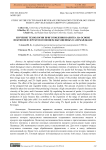
Статья научная
An optimal variant of food used to provide the human organism with biologically active substances that is considered acceptable to every consumer is fruit and vegetable-based juice, which biological value is determined by the maximum retention of nutrients in the product during processing. As the research was related to the preparation of a pectin-rich beverage, the Palavkadu 268 variety of pumpkin, which is a melon fruit, and orange juice were used as the main components of the product. To this end, first of all, the obtained pumpkin puree was treated with enzymes, and then orange juice was added to the mass. Besides, the recipe of the product included sugar, milk powder, sourdough, and 2% liquid pectin. The finished product was made on the basis of this mixture. The effect of the types and concentrations of pectic substances on the probiotic properties of the prepared fruit and vegetable drinks was also studied. The amount of pectin in fruit juice should be taken into account when producing it because a high concentration of pectin increases the viscosity of the juice, and it becomes turbid. By regulating the amount of pectin, it is possible to increase the juice yield. The enzymes of microbial origin are the most widely used substances in the production of juice because they contribute to the expansion of the range of products and the achievement of high juice yield. As a result of our research, it can be concluded that a product with a better bifidogenic effect can be obtained when using 2% liquid pectin in the preparation of beverages.
Бесплатно
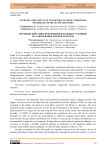
Studying the Effect of Fungicides in Field Conditions on Disease of Fruits of Tomatoes
Статья научная
Tomato is one of the most important food crops. In recent years, tomatoes have been found to be susceptible to various diseases that damage the crop. One of these diseases is black mold of tomato fruits (alternariosis). Leaves, stems and fruits of the plant are damaged. Dark brown or black lesions develop on tomato fruits. The resulting tissue damage is more common where the fruit is attached to the twig.
Бесплатно
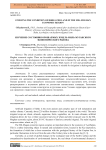
Studying the condition of irrigated land in the Mil-Mughan economic region
Статья научная
The article examines the current reclamation state of irrigated lands in the Mil-Mughan economic region. There are favorable conditions for irrigation and growing heat-loving crops. However, the development of irrigated agriculture here is limited by soil salinity, which is widespread in the study area over quite large areas. Thick layers of soil and groundwater are susceptible to salinization. Conventionally, the territory is suitable for irrigation in hydrogeological and reclamation terms.
Бесплатно

Studying the condition of irrigated land in the Mil-Mughan economic region
Статья научная
The article examines the current reclamation state of irrigated lands in the Mil-Mughan economic region. There are favorable conditions for irrigation and growing heat-loving crops. However, the development of irrigated agriculture here is limited by soil salinity, which is widespread in the study area over quite large areas. Thick layers of soil and groundwater are susceptible to salinization. Conventionally, the territory is suitable for irrigation in hydrogeological and reclamation terms.
Бесплатно
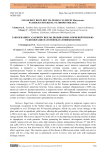
Sugar beet root-rot illnesses caused by Rhizoctonia: pathogen diversity, pathophysiology
Статья научная
Sugar beet, a biennial root crop, is primarily grown in temperate regions and is increasingly recognized in the biofuel industry as a raw material for ethanol production. It is susceptible to over 20 fungal and 10 bacterial pathogens, which can cause severe damage to the plant and result in significant yield losses, affecting the profitability of growers. One such pathogen is Rhizoctonia spp., a soil-borne fungus that causes root and crown rot diseases and losses during storage periods. Rhizoctonia species live in the soil or on decomposing and drying sections of plants as saprophytes or weak parasites. Factors promoting the disease's development include heavy rainfall, organic-rich soil, heavy soils, high moisture content, temperatures between 35° and 40°C, and a pH of 6.0 to 8.0. Poor drainage systems in the soil also contribute to the development of the disease. Crown rot, first discovered in 1858, is one of the common and devastating diseases that affect sugar beet crops. The causative agent of this disease is Rhizoctonia solani, which can survive under soil for a long time and is particularly severe in heavy soils and soils with inadequate drainage systems.
Бесплатно
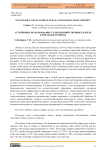
Sustainable use of agricultural land of Khachmaz district
Статья научная
Land use, like any other natural resource, involves loads on nature and causing harm to it. Therefore, completely harmless production today is considered impossible. Because of this, goals have been identified that establish the rationality of land use. Such goals include, taking into account natural conditions and economic indicators in the corresponding territory, ensuring the interests of society as a whole, the efficiency of the production process, as well as the protection of the quality of land and its reproduction. These goals are always unchanged, and their achievement depends on the technological development of production, the economic level, and the needs of society. In this article, the agricultural suitability level of Khachmaz district land was analyzed based on the cadastral database created on the basis of GIS technologies. It was also noted the need to take a number of measures to reduce the risk of soil erosion.
Бесплатно
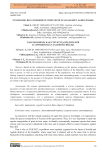
Taxonomic relationship of wide pests in sugar beet agrocenosis
Статья научная
Based on the conducted research, information on the species composition of pests that spread in the agricultural farms of Imishli and Agdash districts of the Republic, where sugar beet is grown, as well as in the private backyards of the population, was reflected in the article. During extensive research conducted in stationary areas and surrounding areas, it was determined that pests belonging to the groups of Coleoptera, Hemiptera, Orthoptera, Diptera and Lepidoptera are found in the agrocenosis of sugar beet.
Бесплатно
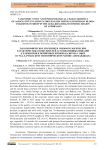
Статья научная
Research was conducted to study the parasite fauna of sheep in the Guba-Khachmaz economic region of Azerbaijan and the species composition of pathogenic parasites causing a decrease in productivity and mortality of animals was determined. The nematode fauna of sheep in the Guba-Khachmaz economic region consisted of 22 species, the trematode fauna consisted of 4, and the cestode fauna consisted of 5 species. Among the primary blood parasites found in sheep are Anaplasma ovis, which belongs to the Rickettsiales order, and Babesia ovis, Theileria ovis, Th.recondita, which belong to the Piroplasmida order. During the study period, 4337 sheep were examined for helminths in the economic region using the complete and incomplete dissection methods. In 3560 of 4337 sheep, was noted associative invasion by nematodes, cestodes and trematodes (I.E. - 82.1%). Infection with nematodes was accompanied by weight loss and a decrease in the quality of wool in sheep, and intensive invasion with fasciola led to the death of young animals, mainly lambs. Intensive infection of sheep with monieziasis was accompanied by a decrease in appetite and milk yield, weight loss. To determine associative ınvasion of sheep with helminths and primary blood parasites, were examined peripheral blood smears and fecal samples from 3435 animals. Of 3435 samples in 1996, were found to have associative invasion with primary blood parasites and helminths (I.E.-58.1%). Mortality has been reported in lambs under 1 year of age, especially 4-5 months old, associated with primary blood parasites and helminth infections. Ectoparasitic ixodid ticks, which transmit primary blood parasites that parasitize animals in the Guba-Khachmaz economic region, are classified into 2 genera, consisting of 4 species.
Бесплатно
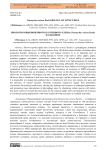
Tetranychus urticae Koch biology on apple trees
Статья научная
The two-spotted spider mite ( Tetranychus urticae Koch) is a polyphagous arthropod herbivore that consumes over 1,100 plant species from 140 distinct plant families, including those producing harmful chemicals in temperate and tropical climates. It is an important pest in greenhouse and field cultivation, causing damage to various crops such as citrus, apples, grapes, tomatoes, peppers, cucumbers, strawberries, maize, and soy. T. urticae ability to spread over agricultural fields and adapt to environmental stressors is linked to its high propensity for mutation, leading to the highest frequency of pesticide resistance among arthropods. The genetic diversity of T. urticae gathered from apple orchards throughout Poland has been studied to investigate potential correlations between molecular variations and the occurrence of resistance to METI-acaricides. Research has shown that an abundance of leaf pubescence on the abaxial leaf surface adversely affects the development of European red mite, two-spotted spider mite, and carmine spider mite. However, due to variations in leaf sizes, tree canopy, tree ages, and the existence of natural enemies, it is impossible to compare data gathered due to variations in leaf sizes, tree canopy, tree ages, and the presence of natural enemies. Pesticide treatments negatively impact fruit plantations' ecosystems, devastating biodiversity, altering the makeup and structure of arthropod populations, and promoting mass reproduction of phytophage mites by displacing certain species with others. The most extensive research has been done on the common spider mite's development of resistance to avermectin group preparations, with some studies showing resistance to multiple acaricides.
Бесплатно
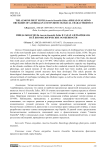
Статья научная
Entomological studies conducted in various regions of Azerbaijan have revealed that one of the most harmful pests of almond orchards is the Anarsia lineatella Zeller, 1839). The pest typically produces 2–3 generations during the vegetation period, while overwintering in the 2nd– 3rd larval instar within buds and bark cracks. By damaging the seed part of the fruits, the almond fruit moth causes yield losses of up to 30–40%. Observations carried out in different landscapeecological zones indicate that the pest’s development rate and reproductive capacity vary depending on the climatic conditions of the regions. Based on the conducted research, the biological features, phenology, and natural enemies of the almond fruit moth have been studied, and scientific foundations for integrated control measures have been developed. This article presents the bioecological characteristics, life cycle, and phenological stages of Anarsia lineatella Zeller in almond orchards of Azerbaijan, including the Absheron region, as well as the results of observations carried out against this pest.
Бесплатно
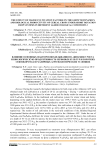
Статья научная
During the research, the highest indicators for both crops at the Absheron AEF were obtained under soil cultivation at a depth of 20‒22 cm (plowing + discing + cultivation) and the application of N120P90K60 fertilizers for winter wheat, and for barley under the same soil treatment with N100P90K60 fertilizers. In the traditional soil cultivation system for winter wheat and barley, depending on the applied fertilizers, the dry matter mass was 1559.2‒1025.1 g, the mass of grain per plant was 509.1‒452.3 g, the number of productive stems was 397‒365 units, and the mass of 1000 grains was 45.0‒41.8 g. In the variant with heavy disc cultivation at a depth of 10‒12 cm with two passes, these indicators were 1417.6‒940.1 g; 443.4‒400.3 g; 344‒323 units, and 43.2‒40.0 g respectively. The results of soil cultivation in the semi-arid conditions of the Jalilabad Regional Experimental Station showed different results compared to the Absheron AEF. Under the use of N80P60K45 and N60P60K40 fertilizers for winter wheat and barley, and with the heavy disc cultivation at a depth of 10‒12 cm with two passes, the dry matter mass was 875.0‒670.2 g, the mass of grain per plant was 303.3‒275.4 g, the number of productive stems was 270.3‒316.3 units, and the mass of 1000 grains was 49.9‒46.2 g.
Бесплатно
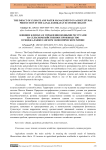
Статья научная
The Ganja-Dashkesan economic region has a predominantly semi-desert and steppe climate. The area consists of mountains and plains on the northeastern slopes of the Lesser Caucasus. These natural and geographical conditions create conditions for the development of various agricultural sectors. Global climate change and the region's water availability have a significant impact on agricultural production. Climatic factors are among the main determinants of crop diversity and productivity in the region. A sharp decline in precipitation has led to increased drought, the use of water resources dependent on transboundary rivers, and a significant reduction in phytomass. There is a close correlation between average annual precipitation dynamics and the index of physical volume of agricultural production. Irrigation systems and canals do not meet modern standards and are poorly managed, which is one of the main problems hindering agricultural development in the region.
Бесплатно
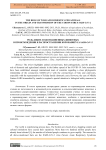
Статья научная
The review highlights animal coronaviruses, their pathogenicity, and the possible role of domestic and agricultural animals in the further spread of the COVID-19. Joint researches have been established amongst an international team of scientists regarding a close phylogenetic relationship of the coronavirus SARS-CoV-2 with the coronaviruses of bats and carnivores, especially with the representatives of the Felidae family (domestic cats). However, the case of Middle Eastern SARS transmitted by camels has required special attention to biological safety measures in farms.
Бесплатно
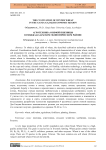
The cultivation of winter wheat in the Ganja-Gazakh economic region
Статья научная
To obtain a high yield of wheat, the described cultivation technology should be observed. Consideration should be given to the biological characteristics of winter wheat, varieties, soil preparation for sowing, sowing dates, sowing rates, irrigation, fertilization, disease and pest control, and, finally, timely harvest without losses in accordance with relevant conditions. Since winter wheat is demanding on mineral fertilizers, one of the most important factors was the determination of the norms of nitrogen, phosphorus and potash fertilizers. Taking into account the fact that the chemical composition of winter wheat grain is not constant, but varies depending on the type and variety, climatic conditions, soil fertility, cultivation technology, a technology has been developed for growing 4 different varieties of winter wheat. For the Ganja-Kazakh economic region to obtain high-quality grain, which makes it possible to obtain an average yield of 50-60 centners per 1 ha.
Бесплатно
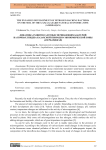
Статья научная
The study of the nitrogen cycle in nature is of great importance, because as a result of anthropogenic impacts the small changes cause the chemical pollution of the soil. The effect of anthropogenic and environmental factors to the productivity of azotobacter cultures on the soils of the Ganja-Gazakh natural economic zone has been described in the article.
Бесплатно
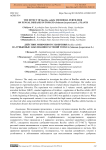
Статья научная
The study was conducted to investigate the effect of Bacillus subtilis on tomato plant diseases. The study area is Samukh district of the Republic of Azerbaijan. Our studies were conducted on experimental plants in the laboratory of plant disease diagnostics of the Azerbaijan State Agrarian University. The experiment was conducted in 3 variants: control, application of microbial fertilizer (MGT), standard application of fertilizer + application of Bacillus subtilis (SGT + MGT). Tomato plant cuttings are planted in pots after application of microbial fertilizer (1 ml / 10 l). At the beginning of flowering, fertilizer (1 ml / 100 l) was applied as a spray on the leaves. When comparing the experimental variants, it was confirmed that high tomato yield and disease resistance are observed when using microbial fertilizer. The study of the effect of Bacillus subtilis bacteria on tomato plant diseases has not been previously conducted in Azerbaijan.
Бесплатно
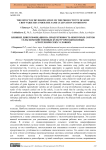
Статья научная
Sustainable farming practices include a variety of approaches. The most important approach to sustainable agriculture is crop diversification. This allows farmers to use biological cycles to minimize costs, conserve the resource base, maximize crop yields, and reduce environmental risk. It serves as an important opportunity to augment income and employment generation for rural communities. In contrast to specialized agriculture, crop diversification can be defined as an attempt to promote crop diversity through crop rotation, perennials or mixed cropping with the aim of improving crop performance, sustainability and supply of ecological systems. This can be a step towards more sustainable production systems, value chains for small crops and socio-economic benefits. Expanded agricultural diversity, better crop rotations, mixed cropping, cultivation of grain legumes in systems that are generally dominated by cereals, perennials, and regionally adapted (specialized) varieties are all examples of crop diversification strategies. As a result of the research carried out in the article, it can be noted that by carrying out the crop diversification under the irrigation and the same cultivation conditions, it is possible to obtain high and quality grain products from the varieties of feed peas Azerbaijan 1508 (green mass), wheat Gobustan and barley Jalilabad-19. This method is considered to be efficient both economically and cultivatically.
Бесплатно
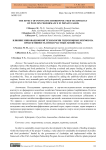
The effect of innovative hydroponic feed technology on poultry performance in private farms
Статья научная
The research was carried out at the Scientific Research Veterinary Institute and in the subsidiary farms of the Khachmaz district (Azerbaijan). The article presents data on the development of poultry farming and food production. To develop a rational and proper feeding of poultry, the addition of antibiotic-effective plants with high nutritional qualities, to the feeding of chickens was used. This led to an increase in meat productivity, a reduction in feeding costs, and an improvement in productivity. Thus, an experiment was conducted by adding the antibiotic-effective plants of sorghum, licorice root, amaranth grain and hydroponically germinated corn, barley, amaranth and sorghum grain to the feed share of young birds to study the effect on meat productivity.
Бесплатно

